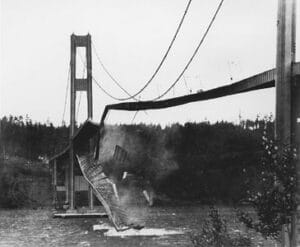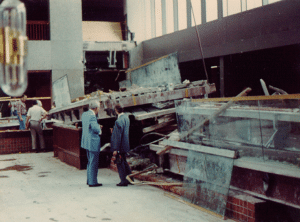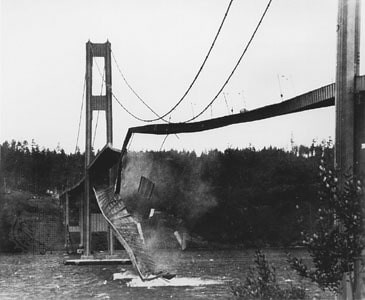In the world of mechanical engineering, the choice of materials plays a pivotal role in determining the strength, durability, and performance of a product. In this post, we will delve into the intricate process of design and material selection and explore the strategies and considerations engineers must take into account when designing robust and reliable mechanical systems. This will be explained through two real-world events.
Design and Material Selection in Engineering History:
Tacoma Narrows Bridge failure
The Tacoma Narrows Bridge, spanning the Tacoma Narrows strait of Puget Sound in Washington state, is infamous for a catastrophic incident that occurred on November 7, 1940. This event serves as a stark reminder of the critical importance of material selection in engineering and design.
Background:
- The Tacoma Narrows Bridge was designed as a suspension bridge with a slender and elegant design, earning it the nickname “Galloping Gertie” due to its characteristic sway in the wind.
Incident:
- On that fateful day in 1940, aeroelastic flutter, a phenomenon where aerodynamic forces cause structural oscillations, set in due to the bridge’s unique design.
- Despite being constructed with steel, the bridge’s narrow deck and lightweight materials couldn’t withstand the violent torsional forces generated by the flutter.

Lessons Learned:
- Material Strength and Rigidity: The incident highlighted the importance of material strength and rigidity in engineering design. The original design did not adequately consider the dynamic forces acting on the bridge.
- Material Fatigue: The materials used in the construction were not sufficiently resistant to fatigue, especially in the presence of repeated dynamic loading.
- Material Testing and Analysis: After the disaster, extensive material testing and analysis became a standard practice in engineering projects. Engineers now pay close attention to material properties and how they behave under various conditions.
- Wind Tunnel Testing: The failure also emphasized the need for wind tunnel testing to evaluate the aerodynamic stability of structures, especially those with unique designs.
Reconstruction:
- After the collapse, a more robust design was implemented, incorporating improved material selection, stronger steel, and aerodynamic considerations.
- The rebuilt Tacoma Narrows Bridge, completed in 1950, has since stood as a testament to the lessons learned from the disaster.
The Tacoma Narrows Bridge disaster remains a prominent example of how material selection and engineering decisions can have dire consequences when not given due diligence. It underscores the importance of considering material properties, structural integrity, and dynamic forces in mechanical engineering design. The lessons learned from this incident continue to shape the field of engineering today, emphasizing the need for rigorous analysis and testing in material selection and design processes.
Let’s look at another example.
The Hyatt Regency Hotel walkway collapse
The Hyatt Regency Hotel walkway collapse in Kansas City in 1981 serves as a sobering reminder of the critical role material selection and construction practices play in structural engineering.
Background:
- The Hyatt Regency Hotel featured a multi-story atrium with three suspended walkways, each connected by a series of steel hanger rods.
- The design was intended to create an open and visually appealing space within the hotel.
Incident:
- On July 17, 1981, during a tea dance event in the atrium, the second and fourth-floor walkways collapsed.
- The incident resulted in 114 fatalities and over 200 injuries, making it one of the deadliest structural engineering failures in the United States.

Causes and Lessons Learned:
- Material Selection: The original design specified one continuous rod per hanger to support both walkways. However, this design was changed during construction to save costs, using a single rod to support both walkways.
- Lesson: Material selection should align with the structural integrity requirements and original design specifications. Cost-cutting decisions that compromise safety can lead to catastrophic failures.
- Design Changes and Review: The change in the design of the hanger rods was not properly reviewed and approved by structural engineers.
- Lesson: Rigorous review and approval processes for design changes are essential to maintain structural safety.
- Material Fatigue: The hanger rods were subjected to repeated loads during construction and use, causing fatigue over time.
- Lesson: Engineers must consider the fatigue life of materials and ensure they meet the required standards and specifications for the intended use.
- Construction Quality Control: The quality of construction and inspections during the project was inadequate.
- Lesson: Rigorous quality control and inspections are vital to ensure that materials are properly installed and meet safety standards.
Reconstruction:
- Following the tragedy, the Hyatt Regency Hotel was extensively renovated and redesigned to improve safety.
- New walkways were constructed with proper engineering and material selection.
The Hyatt Regency walkway collapse is a tragic example of how failures in material selection, design changes, and construction practices can lead to devastating consequences. It highlights the importance of adhering to engineering specifications, conducting thorough reviews, and prioritizing material integrity in structural engineering projects. The incident serves as a lasting reminder of the need for diligence and adherence to safety standards in the field of mechanical engineering.
Conclusion
In summary, the Tacoma Narrows Bridge and Hyatt Regency Walkway incidents underscore the paramount importance of meticulous design and material selection in engineering. These lessons from history emphasize that choices in these domains profoundly impact safety, integrity, and success in the field of mechanical engineering
The significance of design and material selection in engineering cannot be overstated. These factors serve as the foundation for structural integrity, safety, and performance in any mechanical project. Meticulous design and material selection are pivotal in creating robust and reliable engineering solutions while mitigating risks and ensuring longevity.

